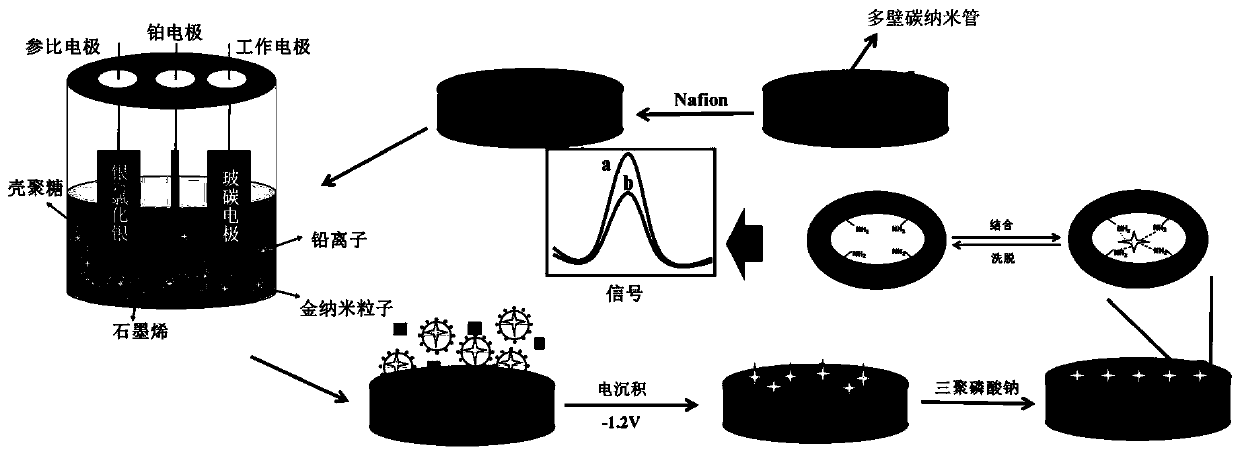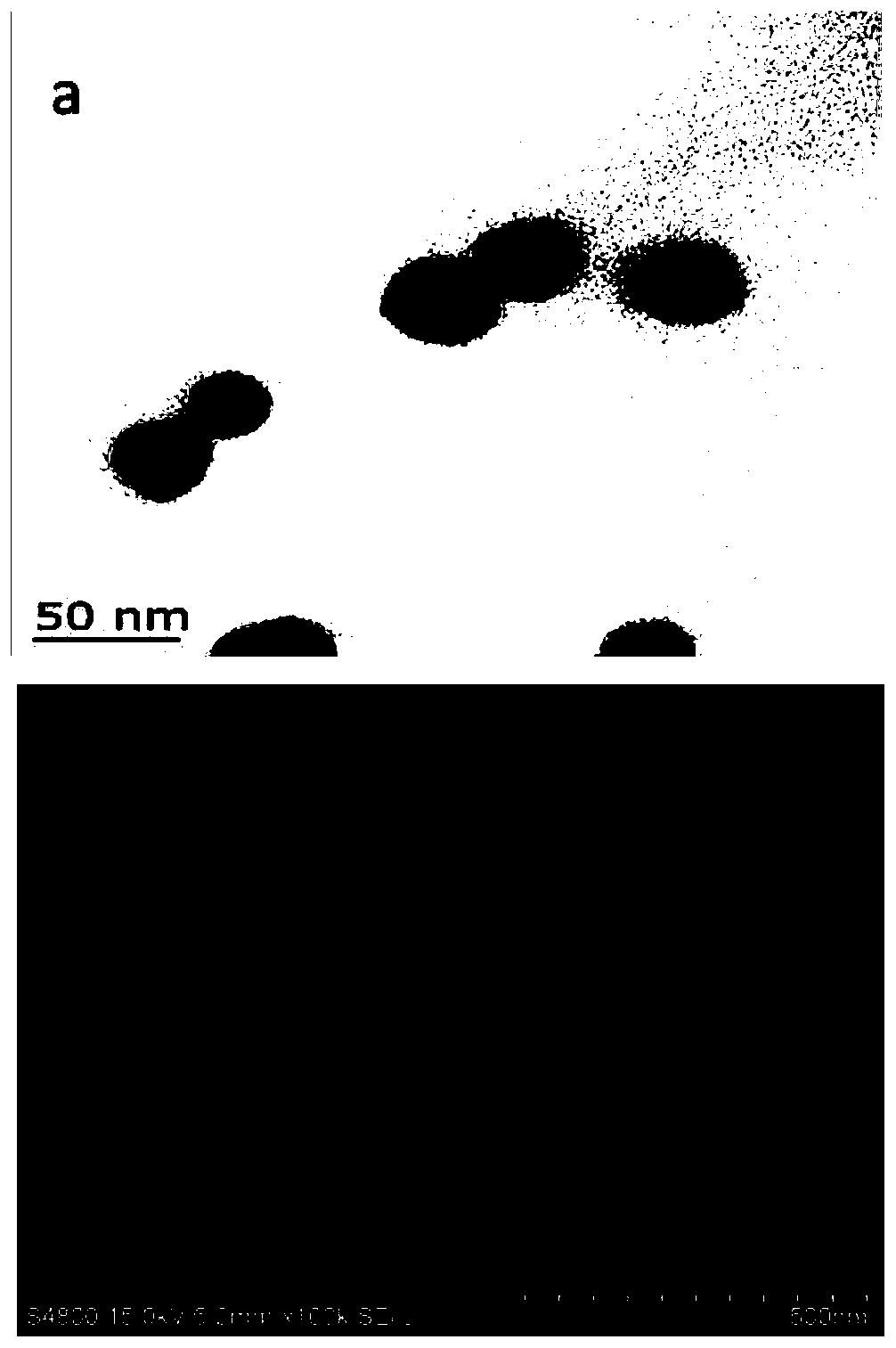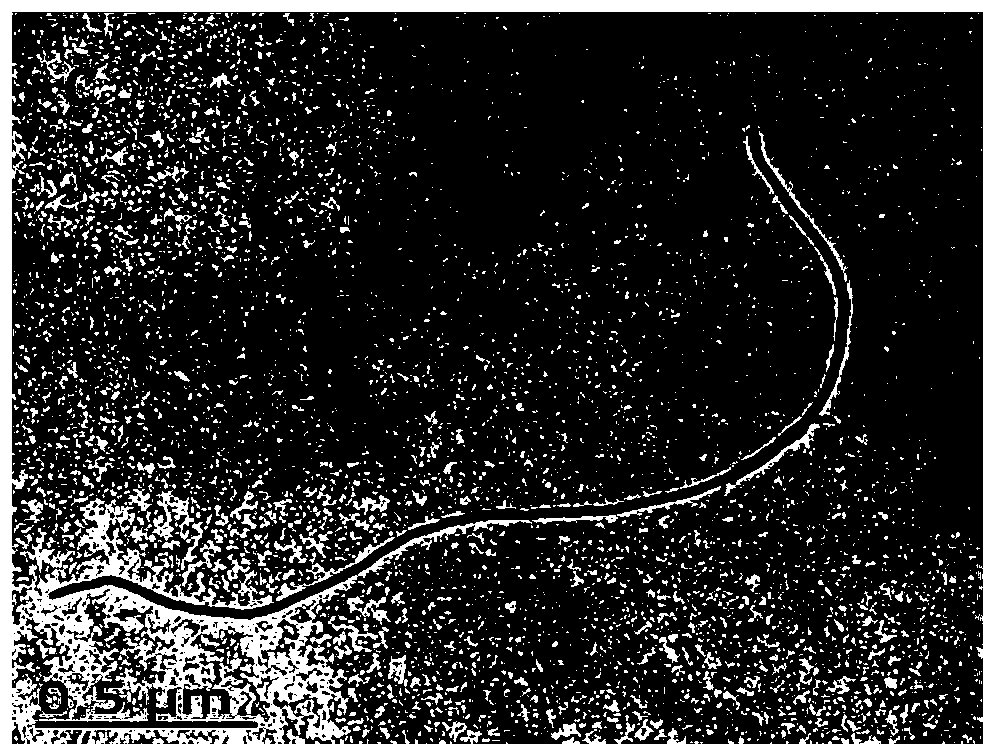A preparation method of chitosan-graphene/gold nanoparticles@carbon nanotube ion imprinted sensor
A technology of gold nanoparticles and carbon nanotubes, which is applied in the direction of instruments, scientific instruments, and electrochemical variables of materials, etc., to achieve excellent anti-interference ability, simple production, and fast response
- Summary
- Abstract
- Description
- Claims
- Application Information
AI Technical Summary
Problems solved by technology
Method used
Image
Examples
Embodiment 1
[0033] (1) Soak the three-neck flask with aqua regia, rinse the flask with a large amount of deionized water, rinse it with ultrapure water for 3 times, and dry it upside down. Place 100mL chloroauric acid solution (0.02wt.%) in a 250mL three-necked flask, stir magnetically, heat and boil for 10min until the solution is yellowish brown, then add 5mL 2wt.% sodium citrate solution to the boiling solution, and the solution Become dark blue, continue to boil 10min, solution color becomes lighter gradually, stop heating then, obtain wine red nano-gold solution after room temperature cooling, the gold nano-particle that makes is spherical, diameter 10-20nm ( figure 2 a);
[0034] (2) Use Al 2 o 3 The powder was mechanically polished to a smooth mirror surface, and then ultrasonically cleaned with double distilled water for 3 min each time, repeated three times. The cleaned electrodes were ultrasonically cleaned with absolute ethanol and twice distilled water for 5 min, and dried...
Embodiment 2
[0038] (1) Soak the three-neck flask with aqua regia, rinse the flask with a large amount of deionized water, rinse it with ultrapure water for 3 times, and dry it upside down. Place 100mL chloroauric acid solution (0.02wt.%) in a 250mL three-necked flask, stir magnetically, heat and boil for 10min until the solution is yellowish brown, then add 5mL 2wt.% sodium citrate solution to the boiling solution, and the solution Turn into dark blue, continue to boil for 10min, the color of the solution gradually becomes lighter, then stop heating, and obtain a wine-red nano-gold solution after cooling at room temperature. The prepared gold nanoparticles are spherical, with a diameter of 10-20nm ( figure 2 a).
[0039] (2) Use Al 2 o 3 The powder was mechanically polished to a smooth mirror surface, and then ultrasonically cleaned with double distilled water for 3 min each time, repeated three times. The cleaned electrodes were ultrasonically cleaned with absolute ethanol and twice...
Embodiment 3
[0043] (1) Soak the three-neck flask with aqua regia, rinse the flask with a large amount of deionized water, rinse it with ultrapure water for 3 times, and dry it upside down. Place 100mL chloroauric acid solution (0.02wt.%) in a 250mL three-necked flask, stir magnetically, heat and boil for 10min until the solution is yellowish brown, then add 5mL 2wt.% sodium citrate solution to the boiling solution, and the solution Turn into dark blue, continue to boil for 10min, the color of the solution gradually becomes lighter, then stop heating, and obtain a wine-red nano-gold solution after cooling at room temperature. The prepared gold nanoparticles are spherical, with a diameter of 10-20nm ( figure 2 a).
[0044] (2) Use Al 2 o 3 The powder was mechanically polished to a smooth mirror surface, and then ultrasonically cleaned with double distilled water for 3 min each time, repeated three times. The cleaned electrodes were ultrasonically cleaned with absolute ethanol and twice...
PUM
| Property | Measurement | Unit |
|---|---|---|
| diameter | aaaaa | aaaaa |
Abstract
Description
Claims
Application Information
 Login to View More
Login to View More - R&D
- Intellectual Property
- Life Sciences
- Materials
- Tech Scout
- Unparalleled Data Quality
- Higher Quality Content
- 60% Fewer Hallucinations
Browse by: Latest US Patents, China's latest patents, Technical Efficacy Thesaurus, Application Domain, Technology Topic, Popular Technical Reports.
© 2025 PatSnap. All rights reserved.Legal|Privacy policy|Modern Slavery Act Transparency Statement|Sitemap|About US| Contact US: help@patsnap.com



